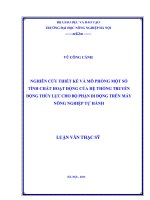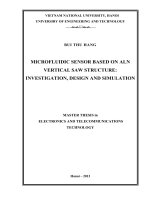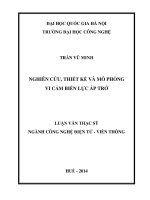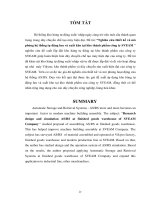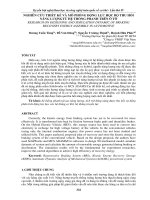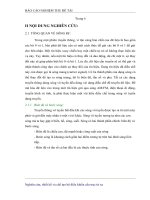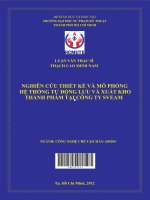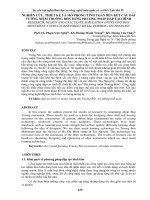DSpace at VNU: Nghiên cứu, thiết kế và mô phỏng bộ cảm biến vi lỏng có cấu trúc SAW đứng trên vật liệu AIN
Bạn đang xem bản rút gọn của tài liệu. Xem và tải ngay bản đầy đủ của tài liệu tại đây (922.82 KB, 6 trang )
Nghiên cứu, thiết kế và mô phỏng bộ cảm biến
vi lỏng có cấu trúc SAW đứng trên vật liệu AIN
Bùi Thu Hằng
Đại học Công nghệ
Ngành: Kỹ thuật điện tử; Mã số: 60 52 70
Người hướng dẫn: TS. Vũ Huy Thông, MBA Hà Nguyên
Năm bảo vệ: 2013
Abstract: Trình bày các thành phần và đặc tính truyền sóng của SAW hoạt
động trong môi trường lỏng và điều kiện truyền giữa hai môi trường. Nghiên
cứu các tính chất điện và cơ của SAW trên đế áp điện phổ biến hiện nay,
LiNO3, và vật liệu CMOS, AlN, khi có tác động của chất lỏng như mật độ,
độ nhớt và chuyển động trong các kênh cảm biến. Bộ cảm biến SAW cho
ứng dụng vi lỏng. Khả năng tích hợp trong ứng dụng cảm biến mực.
Keywords: Bộ cảm biến vi lỏng; Kỹ thuật điện tử
Content
Microfluidic Sensor based on AlN Vertical SAW structure: Investigation, Design and Simulation
TABLE OF CONTENT
GLOSSARY .............................................................................................................. 3
ACKOWNLEDGEMENTS ..................................................................................... 4
LISTS OF TABLES ................................................................................................. 5
LISTS OF FIGURES ............................................................................................... 6
Chapter 1
Introduction ...................................................................................... 8
1.1
Motivation and Objectives............................................................................ 8
1.2
Organization of Thesis.................................................................................. 9
Chapter 2
Theoretical Analysis of the AlN-based Microfluidic Sensor ...... 12
2.1
Introduction ................................................................................................ 12
2.2
Surface Acoustic Waves ............................................................................. 13
2.2.1
Shear Horizontal Surface Acoustic Waves (SH-SAWs) ..................... 13
2.2.2
Rayleigh Surface Acoustic Waves (R-SAWs) .................................... 14
2.3
Propagation of Acoustic Waves in contact with a Liquid Medium ........... 16
2.3.1
Boundary Conditions ........................................................................... 19
2.3.2
Standing and Linear Motion Medium.................................................. 19
2.3.3
Moving Liquid Medium....................................................................... 20
2.4
Equivalent Circuit Model of SAW Devices ............................................... 21
2.4.1
Model Implementation ......................................................................... 21
2.4.2
Frequency Response ............................................................................ 22
2.4.3
Attenuation........................................................................................... 22
2.5
Conclusion .................................................................................................. 23
Chapter 3
3-D Design of AlN-based Microfluidic Sensor ............................. 24
3.1
General Description .................................................................................... 24
3.2
Design Principles ........................................................................................ 25
3.3
FEM Simulation for AlN-based Microfluidic Sensor ................................ 29
3.3.1
General Configuration ......................................................................... 29
3.3.2
Lithium Niobate ................................................................................... 30
3.3.3
Aluminium Nitride ............................................................................... 33
Bui Thu Hang
Page 1
Microfluidic Sensor based on AlN Vertical SAW structure: Investigation, Design and Simulation
3.4
Masks designed........................................................................................... 35
Chapter 4
Results and Discussion ................................................................... 38
4.1
General Description .................................................................................... 38
4.2
Density and viscosity .................................................................................. 38
4.2.1
Lithium Niobate Crystal ...................................................................... 38
4.2.2
Aluminium Nitride Crystal .................................................................. 43
4.3
Sensing Liquid Status ................................................................................. 45
4.3.1
Constant Velocity ................................................................................ 45
4.3.2
Non-constant Velocity ......................................................................... 49
4.4
Conclusion .................................................................................................. 53
Chapter 5
Conclusions and Future Work ...................................................... 54
5.1
Conclusions ................................................................................................ 54
5.2
Future work................................................................................................. 54
Reference ................................................................................................................. 56
Appendix: Material Parameters for Piezoelectric Substrate ............................. 59
A.
Lithium Niobate .......................................................................................... 59
B.
Aluminium Nitride ..................................................................................... 59
Bui Thu Hang
Page 2
Microfluidic Sensor based on AlN Vertical SAW structure: Investigation, Design and Simulation
eference
[1] Leslie Y. Y. and James R. F., “Ultrafast microfluidics using surface acoustic
waves”, Biomicrofluidics, 2009, 3(1): 012002.
[2] Subhas C. M., Gourab S. G., Yueh-Min R. H., “Recent Advances in Sensing
Technology”, Springer. 2009, ISBN 978-3-642-00577-0.
[3] Aisha Q., James R. F. and Leslie Y. Y., “Investigation of SAW Atomization”,
2009 IEEE International Ultrasonics Symposium Proceedings, pp. 787-790.
[4] Rohan V. R., James R. F. and Leslie Y. Yeo, “Particle concentration via
acoustically driven microcentrifugation: microPIV flow visualization and
numerical modelling studies”, Microfluid Nanofluid (2010) 8:73–84.
[5] Aisha Q., Leslie Y. Y and James R. F., “Interfacial destabilization and
atomization driven by surface acoustic waves”, Physics of Fluids 20, 074103.
[6] D. Morgan, “Surface Acoustic Wave Filters”, Elsevier, New York (1985).
[7] D. S. Ballantine, R. M. White, S. J. Martin, A. J. Ricco and E. T. Zellers, G.
C. Frye and H. Wohltjen, “Acoustic wave sensors – Theory, Design and
Physico – Chemical Applications”, Academic Press, 1997.
[8] Cleland A.N., “Foundations of Nanomechanics. From Solid-State Theory to
Device Applications”, Springer 2002, ISBN 3540436618.
[9] Ferrari V. and Lucklum R. , “Piezoelectric Transducers and Applications”,
Ed. A Arnau Vives, ISBN: 978-3-540-77507-2, 2008, Chapter 2.
[10] Tung B. D., Thu-Hang B., Dat N. T. and Trinh C. D., “R-SAW Analysis on
Single-Crystal AlN Substrate for Liquid Sensors”, ICEMA 2012, pp. 13-18.
[11] Ying C., “Piezoelectricity in zinc oxide-based multilayer structures for sensor
applications”, New Brunswisk, New Jersey, Doctoral thesis 2008.
[12] Thu-Hang B., Tung B. D., Dat N. T. and Trinh C. D., “Attenuation
Coefficient for Surface Acoustic Waves in Fluid Region”, VJM2012, Vol. 34,
No. 4, pp. 225-236.
[13]
Gavignet E., Ballandras S. and Bigler E., “Theoretical analysis of surface
transverse waves propagating on a piezoelectric substrate under shallow groove
Bui Thu Hang
Page 56
Microfluidic Sensor based on AlN Vertical SAW structure: Investigation, Design and Simulation
or thin metal strip gratings”, Journal of Applied Physics, Vol. 7, pp. 6228
-
6233.
[14] Thu-Hang B., Dat N. T., Tung B. D. and Trinh C. D., “3-D Finite Element
Modeling of SAW sensing system for liquids”, The 2012 IEEE/ASME
International Conference on Advanced Intelligent Mechatronics, pp. 782-787.
[15] Shiokawa. S. and Kondoh J., “Surface acoustic wave sensor for liquid-phase
application”, 1999 IEEE ULTRASONICS SYMPOSIUM, pp. 445-452.
[16]
Thomas H. H., Chapter 5 Surface Waves.
[17]
Campell J. J. and Jones W. R., “A method for estimating optimal crystal cuts
and propagation directions for excitation of piezoelectric substrate waves”,
IEEE Trans. on Sonics and Ultrasonics, vol. SU-15, No. 4, 1968.
[18]
Wilson W. C. and Atkinson G. M., “Rapid SAW sensor development tools”.
[19]
W. Richard Smith, H. M. Gerard, J. H. Collins and T. M. Reeder, “Analysis
of Interdigital surface acoustic wave transducers by use of an equivalent circuit
model”, IEEE Tran. on Microwave theory and Techniques, vol. MIT-17, No. 11,
1969.
[20]
H. Trang, “Design and realization of SAW pressure sensor using Aluminum
Nitride”, thesis 2009, Uni. Joseph Fourier-Grenoble I Sciences. Technologie.
Sante.
[21]
A. Takayanagi, K. Yamanouchi and K. Shibayama, “Piezoelectric leaky
surface wave in LiNbO3”, Appl. Phys. Lett., Vol. 17, No. 5, 225-227(1970).
[22]
K. Yamanouchi and M. Takeuchi, “Application for piezoelectric leaky
surface waves”, Ultrasonics Symposium, pp. 11-18(1990).
[23]
S. Tonami, A. Nishikata and Y. Shimizu, “Characteristics of leaky surface
acoustic waves propagating on LiNbO3 and LiTaO3 substrates”, Jpn. J. Appl.
Phys., Part 1, Vol. 34, No. 5B, 2664-2667(1995).
[24]
J. Semmlow, “Signals and systems for bioengineers”, Elsevier Inc. ISBN:
978-0-12-384982-3, , 2nd Edition, 2011.
Bui Thu Hang
Page 57
Microfluidic Sensor based on AlN Vertical SAW structure: Investigation, Design and Simulation
[25]
K. Shin and J. K. Hammond, “Fundamentals of signal processing for sound
and vibration engineers”, John Wiley & Sons Ltd, ISBN-13 978-0470-51188-6,
2008.
[26]
G. Zhang, “Orientation of Piezoelectric Crystals and Acoustic Wave
Propagation”, 2012 COMSOL Conference.
[27]
J. G. Gualtiei, J. A. Kosinski and A. Ballato, “Piezoelectric materials for
acoustic wave applications”, IEEE Tran. on Ultrasonics, Ferroelectrics and
Frequency control, vol. 41, No. 1, 1994.
[28]
G. Bu, D. Ciplys and M. S. Shur, L. J. Schowalter and S. B. Schujman,
“Leaky Surface Acoustic Waves in single-Crystal AlN Substrate”, International
J. of High Speed Electronics and Sys., Vol. 14, No. 3, pp. 837-846, 2004.
Bui Thu Hang
Page 58
